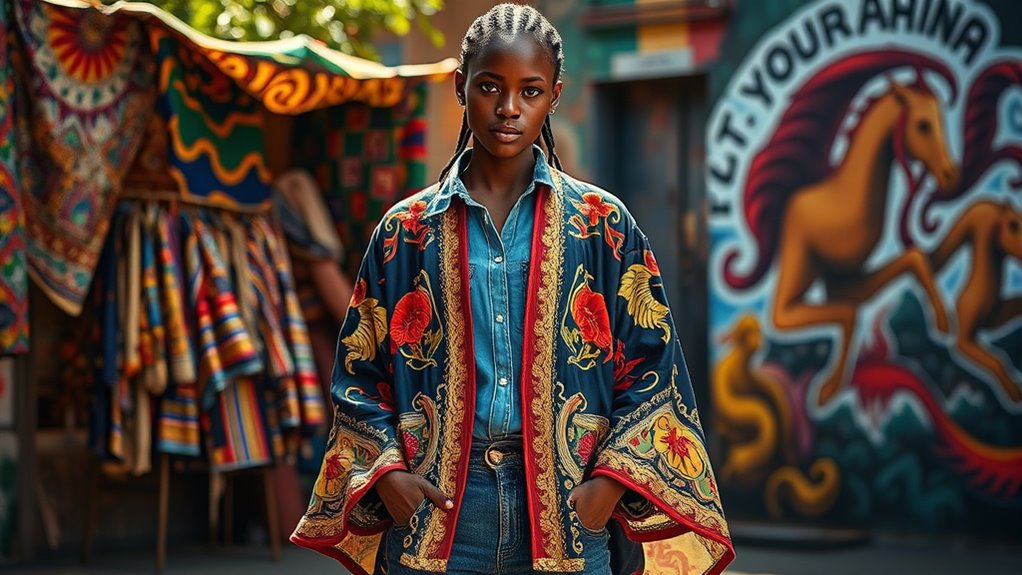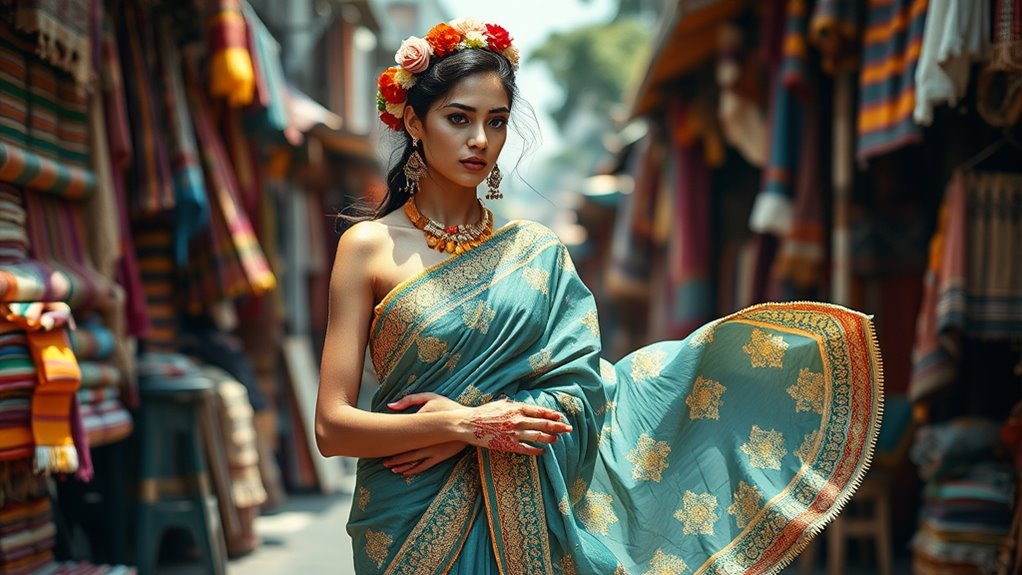You see modern fashion influenced by global traditions through traditional motifs like geometric, floral, or symbolic designs that carry cultural meanings. These elements connect you to history, beliefs, and social values, often blending old symbols with new techniques. Bright colors and textures also reflect cultural identities while making your style unique. When you explore these designs, you’ll discover how fashion becomes a conversation across cultures and generations—there’s much more to uncover beyond the surface.
Key Takeaways
- Traditional motifs like embroidery and symbols encode cultural beliefs, histories, and social values, creating a visual dialogue between past and present.
- Modern designers reinterpret traditional patterns with new techniques, blending old motifs into contemporary fashion statements.
- Bright colors and textures from cultural symbolism are incorporated into designs to evoke identity, status, and spiritual significance.
- Wearing culturally inspired fashion fosters appreciation for global heritage and serves as a form of cultural pride and storytelling.
- Fashion acts as a cultural conversation, connecting communities across generations while celebrating diversity through traditional motifs.

Have you ever wondered how the stories, traditions, and customs woven into a community shape its identity? When you look at fashion today, you might notice patterns, colors, and styles that seem to connect to something deeper than mere aesthetics. These elements often originate from traditional motifs—geometric designs, floral patterns, or symbols passed down through generations. They carry cultural symbolism, representing beliefs, histories, and social values of a community. By incorporating these motifs into modern clothing, designers create a visual dialogue between the past and present, allowing you to wear stories that transcend time.
Traditional motifs carry cultural stories, connecting past beliefs and values with modern fashion’s evolving style.
As you explore different fashion pieces inspired by global traditions, you’ll see how cultural symbolism plays a crucial role. For example, a dash of intricate embroidery from Central Asia, with its symbolic motifs, might be used to enhance a contemporary jacket. These motifs aren’t just decorative; they encode meanings—protection, prosperity, or spiritual connection—that resonate with cultural identities. When you wear these designs, you’re not only showcasing style but also honoring ancestral beliefs and narratives. It’s like carrying a piece of history with you, creating a bridge between communities and eras.
Modern fashion designers often draw from these traditional motifs, reinterpreting them through innovative techniques and materials. This blending of old and new allows you to appreciate cultural symbolism in fresh ways. For instance, a scarf featuring African textile patterns may become a statement piece in a global wardrobe. Through these adaptations, traditional motifs are transformed into symbols of cultural pride and identity, reminding you of the importance of diversity. When you choose clothing inspired by different cultures, you participate in a global exchange that celebrates heritage while embracing contemporary trends.
You might also notice how cultural symbolism influences color choices and fabric textures. Bright reds, blues, and golds often carry specific meanings in various traditions, conveying status, spirituality, or energy. Incorporating these colors into modern design helps you connect visually and emotionally with the culture behind the pattern. This approach democratizes tradition, making it accessible and relevant in today’s fashion landscape. It’s a way to honor the past while expressing your unique identity in the present.
Ultimately, understanding how traditional motifs and cultural symbolism shape fashion enables you to see beyond surface beauty. It reveals a layered dialogue—one that respects history, celebrates diversity, and fosters a deeper appreciation for the world’s rich cultural tapestry. When you wear these designs, you’re not just making a style statement; you’re participating in a vibrant cultural conversation that spans generations. Recognizing the cultural significance of these motifs deepens your connection to their origins and enriches your appreciation of global fashion.
Frequently Asked Questions
How Do Fashion Designers Incorporate Cultural Authenticity Respectfully?
When you want to incorporate cultural authenticity respectfully, focus on cultural sensitivity and genuine appreciation. You can achieve this through artistic collaboration with members of the culture, ensuring their voices shape the design. Avoid stereotypes or superficial use of symbols, and seek permission where needed. This approach shows respect, fosters understanding, and creates meaningful fashion that honors traditions while creating innovative designs.
What Are the Challenges of Blending Multiple Cultural Influences?
Imagine you’re mixing a vintage vinyl with a digital playlist — that’s how blending multiple cultural influences can feel. You might face cultural misinterpretation, risking stereotypes, while trying to respect each tradition’s authenticity. The challenge lies in balancing innovation with identity preservation, ensuring you honor each culture without diluting or misrepresenting it. Steering these influences requires sensitivity and awareness to create respectful, inclusive designs.
How Does Globalization Impact Traditional Clothing Preservation?
Globalization impacts traditional clothing preservation by increasing exposure to new styles, which can both inspire and threaten cultural identity. As you adopt global trends, you might unintentionally diminish the significance of traditional textiles, risking their erosion. However, you can also help uphold these cultural threads by supporting textile preservation efforts and embracing authentic garments. Balancing modern influence with respect for cultural identity ensures traditional clothing thrives amidst global change.
In What Ways Does Cultural Appropriation Affect Fashion Trends?
You might notice cultural appropriation impacting fashion trends through cultural misinterpretation and identity commodification. When designers or brands use elements from a culture without understanding their significance, it can distort their meaning. This often leads to superficial trends that strip away authentic identity, turning cultural symbols into commodities. As a result, you could see a loss of respect for the original traditions, and marginalized communities may feel their heritage is being exploited or misrepresented.
Can Cultural Traditions Adapt to Modern Sustainability Practices?
Imagine cultural traditions as a river flowing through time, adapting to new landscapes. You can see this in how they embrace sustainable craftsmanship and eco-friendly textiles, blending age-old techniques with modern sustainability. This adaptation preserves authenticity while reducing environmental impact. By honoring traditions and innovating responsibly, cultures weave a future where fashion respects both heritage and the planet, proving that old roots can grow new, greener leaves.
Conclusion
You might be surprised to learn that over 70% of modern fashion designers incorporate traditional motifs into their collections. By embracing these cultural threads, you help keep ancient traditions alive while creating innovative styles. When you wear a piece inspired by a distant culture, you’re not just making a fashion statement—you’re supporting global heritage. So next time you shop, consider how your choices connect to a bigger story, shaping a more diverse and inclusive future for fashion.









